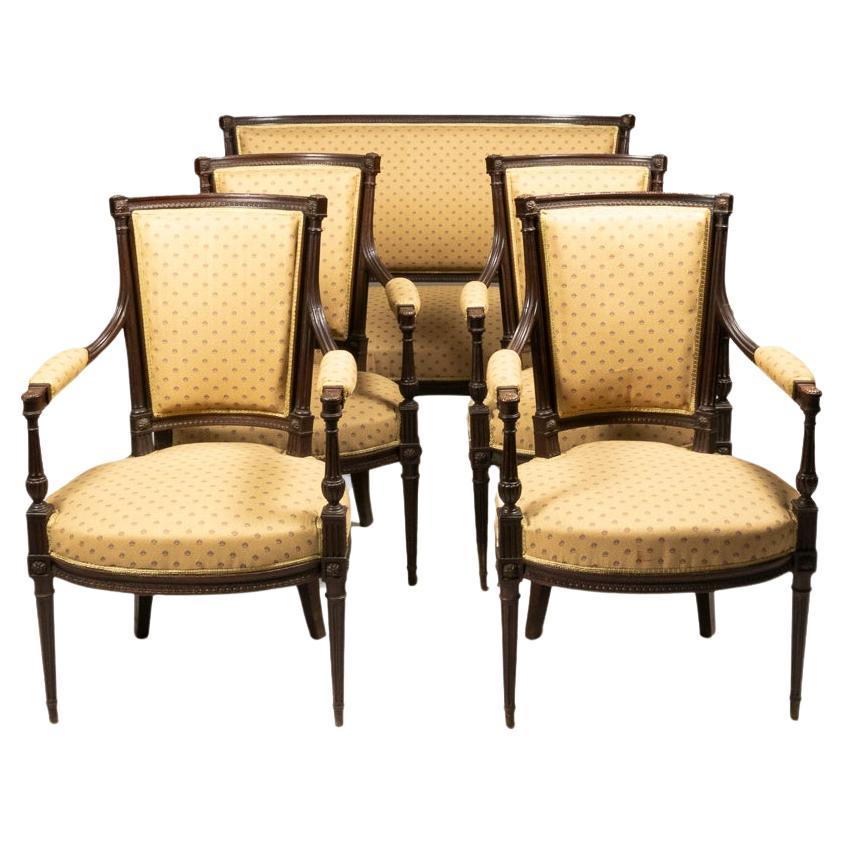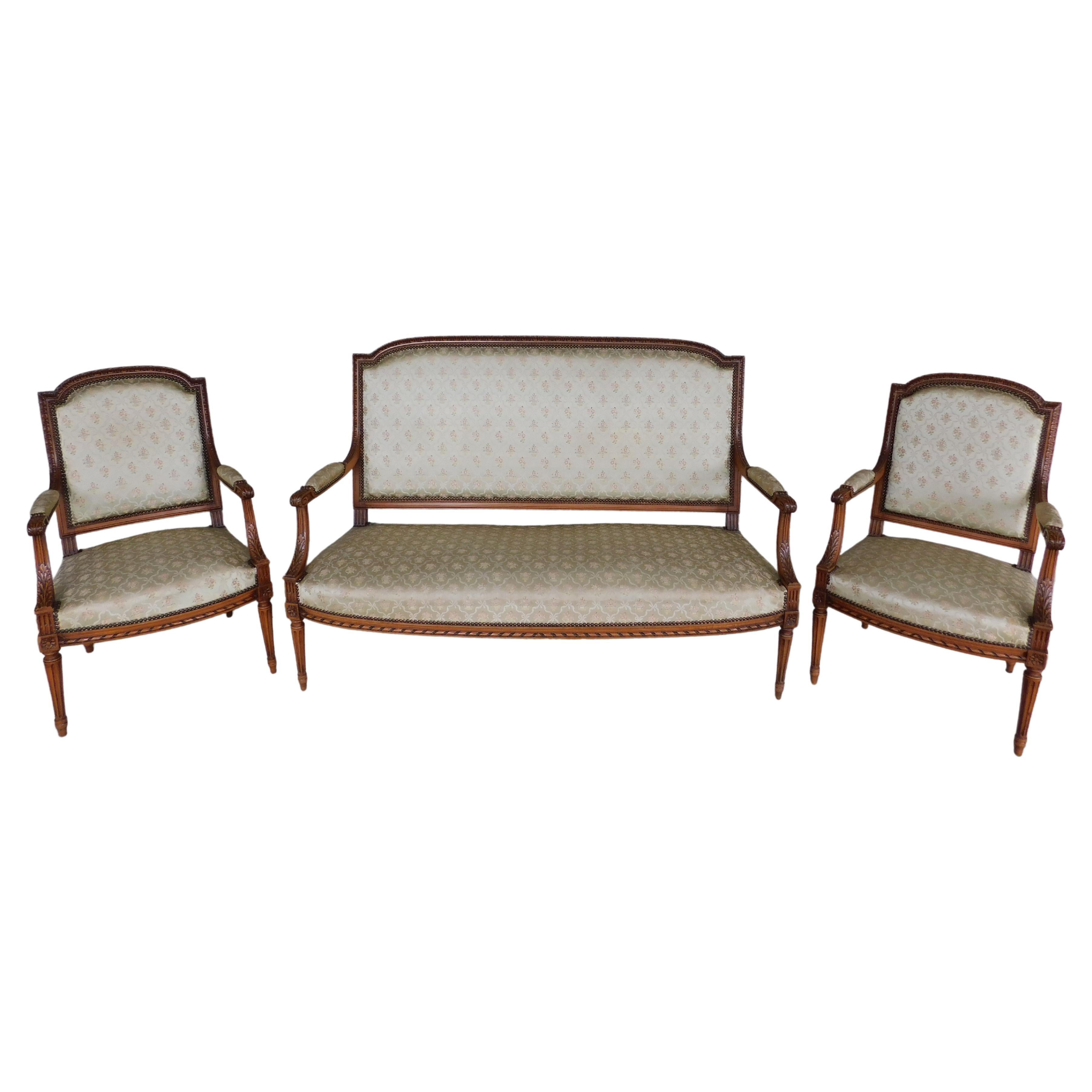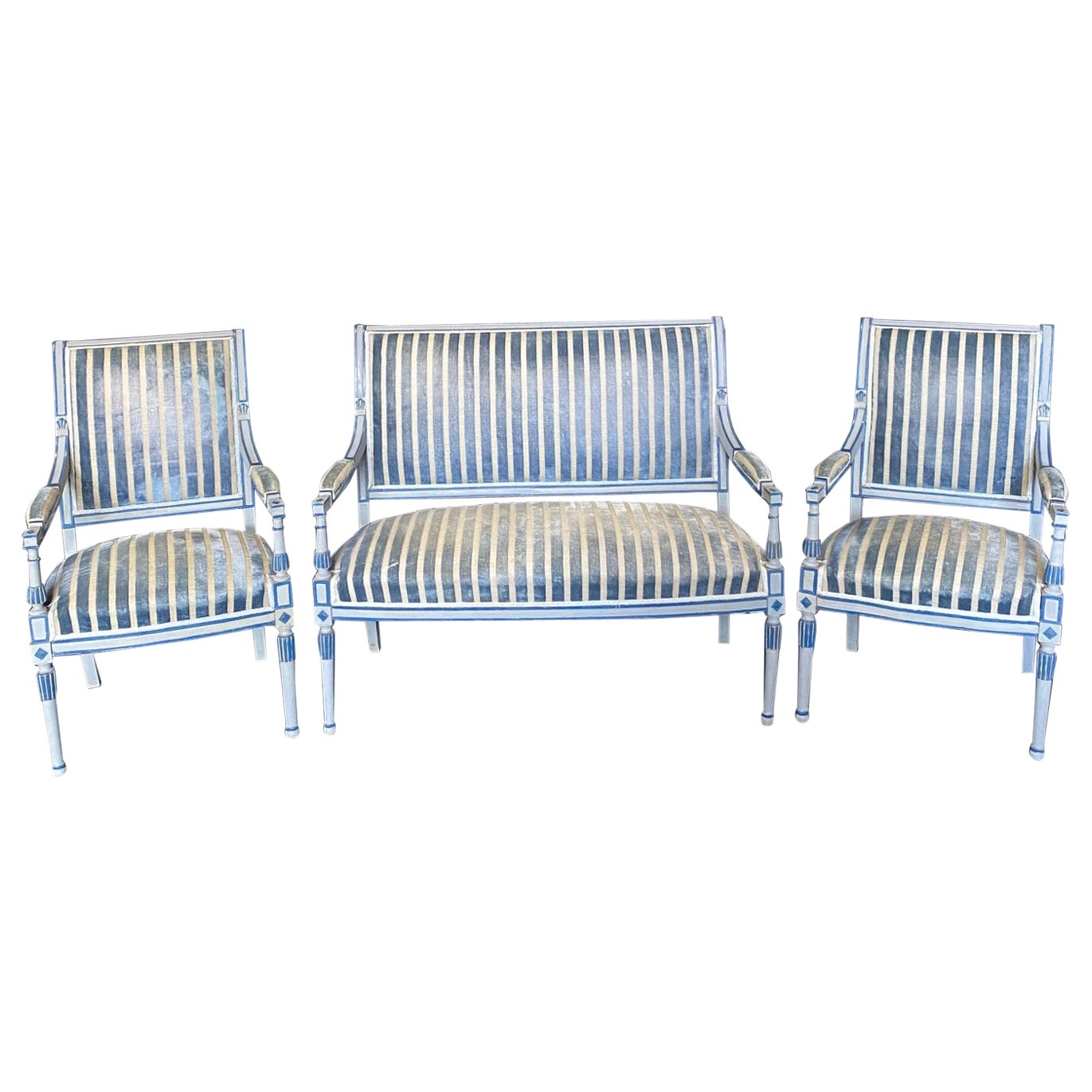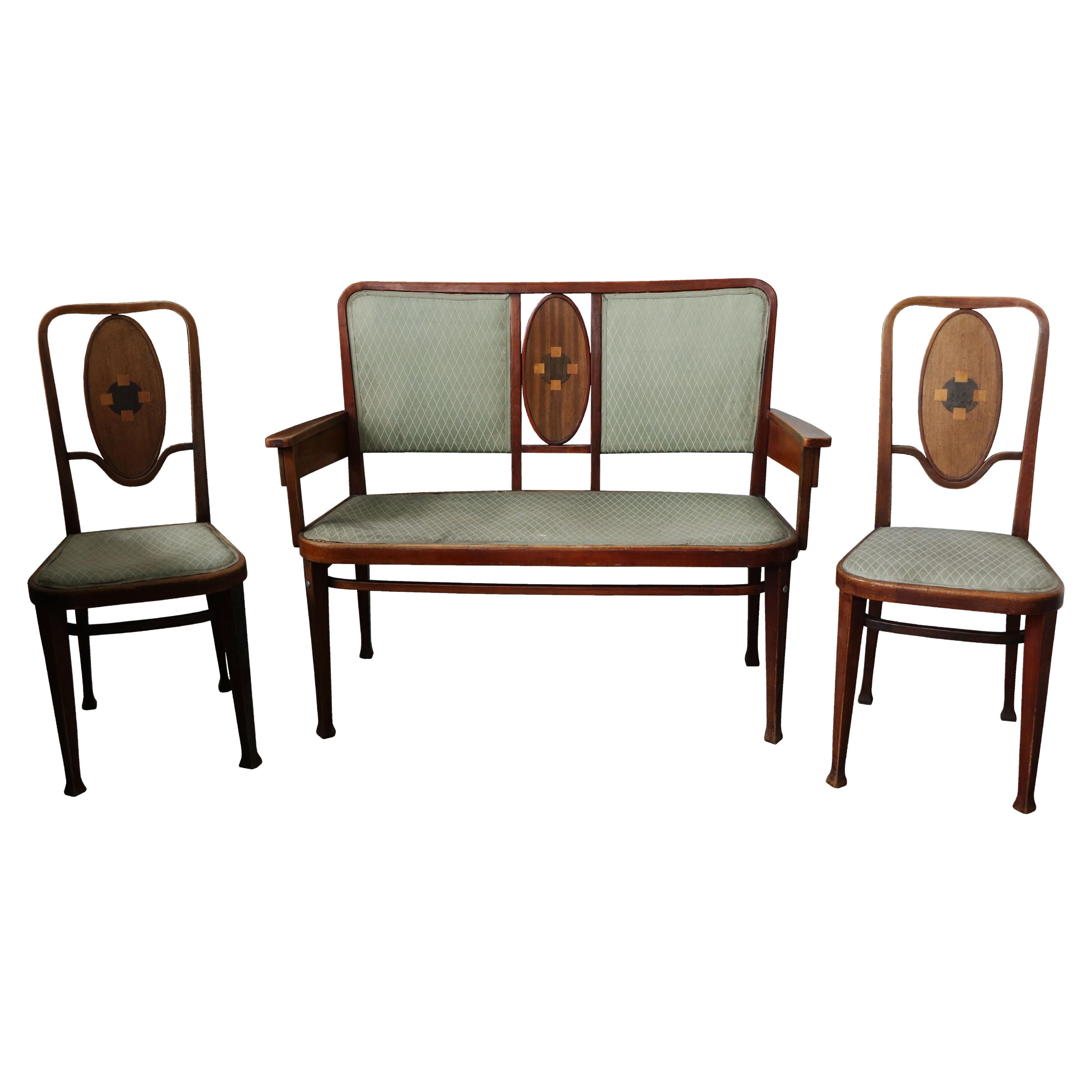Items Similar to 19th Century Rosewood Parlor Set with Carved Backrests
Want more images or videos?
Request additional images or videos from the seller
1 of 16
19th Century Rosewood Parlor Set with Carved Backrests
About the Item
19th Century Rosewood Parlor Set with Carved Backrests
We present you a set composed of a three-seat bench and two armchairs.
All the furniture is from the mid-19th century
Both the bench and armchairs are made of rosewood, whereas the seats are woven.
The backrests are slightly bent backwards, with an openwork, carved pattern.
Presented parlor set is in very good condition.
Every piece has been refreshed with French polish.
Dimensions:
Bench – H 82 cm, W 137 cm, D 53 cm, seat H 39.5 cm.
Armchairs – H 82 cm, W 58 cm, D 53 cm, seat H 39.5 cm.
- Dimensions:Height: 32.29 in (82 cm)Width: 53.94 in (137 cm)Depth: 20.87 in (53 cm)Seat Height: 15.56 in (39.5 cm)
- Sold As:Set of 3
- Materials and Techniques:
- Place of Origin:
- Period:
- Date of Manufacture:1845-1855
- Condition:Refinished.
- Seller Location:Opole, PL
- Reference Number:
About the Seller
4.8
Platinum Seller
These expertly vetted sellers are 1stDibs' most experienced sellers and are rated highest by our customers.
Established in 1995
1stDibs seller since 2018
198 sales on 1stDibs
Typical response time: 1 hour
- ShippingRetrieving quote...Ships From: Katowice, Poland
- Return PolicyA return for this item may be initiated within 10 days of delivery.
More From This SellerView All
- Art Nouveau Parlor Set, Circa 1910Located in Opole, PLWe present you this set composed of a two-seat sofa, and two armchairs. The whole is kept in the Art Nouveau stylistics. The seats are upholstered. The backrests with an openwork slat with cut-outs that supports the upholstered section. The upholstery ends with a top rail. Moreover, the top rail has advanced corners, which are finished with a rosette. The rails and their stands are shaped wavily. This parlor set...Category
Vintage 1910s Italian Art Nouveau Living Room Sets
MaterialsUpholstery, Mahogany
- Parlor Set from the Early 20h Century in Blue UpholsteryLocated in Opole, PLParlor Set from the Early 20h Century in Blue Upholstery We present you small parlor set composed of a two-person sofa and two armchairs. The furniture is openwork, of a lightweight...Category
Early 20th Century European Living Room Sets
MaterialsUpholstery, Wood
- 19th Century Neo-Renaissance Oak BenchLocated in Opole, PLWe present you a two-person Neo-Renaissance bench made of solid oakwood. This piece of furniture is in the form of a chest with a liftable seat, a high, simple backrest, and armrest...Category
Antique Late 19th Century European Benches
MaterialsOak
- Late-19th Century Renaissance Revival Oak Bench With Storage CompartmentLocated in Opole, PLLate-19th Century Renaissance Revival Oak Bench With Storage Compartment We present you this oak bench in the style of Renaissance Revival. It was manufactured in the late 19th cent...Category
Antique Late 19th Century Dutch Renaissance Revival Benches
MaterialsOak
- 19th-Century English Upholstered Armchair with Decorative BackrestLocated in Opole, PL19th-Century English Upholstered Armchair with Decorative Backrest We present you an armchair from the late 19th century of a delicate fo...Category
Antique Late 19th Century English Armchairs
MaterialsUpholstery, Wood
- Set of Decorative Oak Chairs From the, Early 20th CenturyLocated in Opole, PLSet of Decorative Oak Chairs From the Early 20th century. We present you these oak chairs with high backrest. Front legs of the chairs are rounded and seats upholstered with embos...Category
Early 20th Century European Chairs
MaterialsLeather, Oak
You May Also Like
- Nine-Piece 19th Century Parcel Gilt Carved Aubusson Tapestry Parlor SetLocated in New York, NYA fantastic late 19th century nine-piece Louis XV style parcel-gilt carved walnut and Aubusson Tapestry Parlor set. Consisting of four side chairs, four armchairs and a settee, ea...Category
Antique 19th Century French Belle Époque Chairs
MaterialsTapestry, Wood
- Louis XVI 19th Century Five-Piece Parlor SetLocated in Lisbon, PTLouis XVI style salon suite: A five pieces with four armchairs and one canapé in cuban mahogany in “twisted rope” carving style. Yellow upholstery with floral monogram. The structur...Category
Antique 19th Century French Louis XV Living Room Sets
MaterialsUpholstery, Wood
- An Anglo-Dutch 19th Century Walnut Carved 5 Piece Parlor Set, After Daniel MarotLocated in Los Angeles, CAA Fine Anglo-Dutch 19th Century Baroque Style Ornately Carved Walnut Five Piece Parlor - Salon Suite, After Daniel Marot (French-Dutch, 1661–1752); comprising of a settee, two armchairs and two side chairs. The intricately pierced high-backs carved frames with scrolled and floral designs, curved armrests and cabriolet conjoined legs. Circa: 1890. Measures: Settee height: 54 3/4 inches (139.1 cm) Settee width: 70 3/4 inches (179.7 cm) Settee depth: 24 inches (61 cm) Armchairs Height: 52 inches (132.1 cm) Armchairs Width: 28 inches (71.1 cm) Armchairs Depth: 21 1/2 inches (54.6 cm) Side chairs Height: 50 inches (127 cm) Side chairs Width: 21 1/2 inches (54.6 cm) Side chairs Depth: 20 1/2 inches (52.1 cm) Seat height: 20 3/8 inches (51.8 cm). Daniel Marot or Daniel Marot the Elder (1661–1752) was a French-born Dutch architect, furniture designer and engraver at the forefront of the classicizing Late Baroque Louis XIV style. He worked for a long time in England and the Dutch Republic, where he was naturalised in 1709. Born in Paris, he was a pupil of Jean Le Pautre and the son of Jean Marot, who was also an architect and engraver. Marot was working independently as an engraver from an early age, making engravings of designs by Jean Bérain, one of Louis XIV's official designers at the Manufacture des Gobelins, where far more than tapestry was being produced. The family were Huguenots and were part of the wave of émigrés who left France in the year of the Edict of Fontainebleau and Revocation of the Edict of Nantes (1685) to settle in Holland. Daniel Marot brought the fully developed court style of Louis XIV to Holland, and later to London. In the end, the English style which is loosely called "William and Mary" owed much to his manner. In the Dutch Republic, Marot was employed by the Stadthouder, who later became William III of England; in particular, he is associated with designing interiors in the palace of Het Loo, from 1684 on. Though his name cannot be attached to any English building (and he does not have an entry in Howard Colvin's exhaustive Dictionary of British Architects) we know from his own engraving that he designed the great hall of audience for the States-General at the Hague. He also decorated many Dutch country-houses, introducing the “salon” and popularizing ornamented ceilings in The United Provinces/ Netherlands. State bed, designed by Daniel Marot, engraving, ca 1702 In 1694, he traveled with William to London, where he was appointed one of his architects and Master of Works. In England his activities appear to have been concentrated at Hampton Court Palace, where he designed the garden parterres, which were swept away in the following generation and have been restored at the end of the 20th century. His designs for the Great Fountain Garden survive. Much of the furniture, especially the mirrors, guéridons and state beds, in the new State Rooms readied for William at Hampton Court bears unmistakable traces of his authorship; the tall and monumental embroidered state beds, with their plumes of ostrich feathers, their elaborate valances and cantonnieres agree very closely with his later published designs. After William's death Marot returned to Holland where he lived at the Noordeinde 164 in The Hague from 1720 until his death in 1752. The house with his salon, kitchen, hallway and possibly some of his ceilings still exists. We owe much of our knowledge of his work to the folio volume of his furniture designs published at Amsterdam in 1712. Not surprisingly the designs show strong French and Dutch influences; what reads as their "English" look is more probably the result of Marot's court style on other London designers. Marot was a nephew of Pierre Gole...Category
Antique Late 19th Century Italian Baroque Revival Living Room Sets
MaterialsWalnut
- Antique Louis XVI Style Late 19th Century 3pc Parlor SetLocated in Parkesburg, PAFrench Settee & Pair of Louis XVI style armchairs from the Late 19th century. These antique oak framed chairs & settee, with upholstered centers set within a highly carved vertical a...Category
Antique Late 19th Century European Louis XVI Living Room Sets
MaterialsOak
- Elegant 19th Century Carved & Painted French Empire Salon SetLocated in Hopewell, NJSumptuous Belle Louis XVI style carved three-piece salon or parlor set, including a settee and two armchairs, all upholstered in a lovely blue gray fabric with raised velvet stripes....Category
Antique 19th Century French Louis XVI Living Room Sets
MaterialsUpholstery, Wood
- 20th Century Fine Set of Thonet Art Nouveau by Marcel Kammerer. Vienna, C. 1910.By Marcel KammererLocated in Vienna, ATHello, We would like to offer you a beautiful set designed by Marcel Kammerer and manufactured by Thonet in Vienna, c. 1910. The set consists of two chairs and a settee. The pieces were made by the best craftsmen with the use of the finest quality material. Marcel Kammerer designs are characterized by sublime proportions and high quality manufacturing. These high quality set is very rare and difficult to find. The pieces will be a great complement to any elegant interior. It does not matter whether it is a classic or modern interior because Art Nouveau is simply timeless. Viennese Thonet is distinguished by their sophisticated proportions, rare and refined design and excellent craftsmanship and continue to have a great influence on modern design. Marcel Kammerer (1878 Vienna--1959 Montreal) was a successful Viennese architect and designer, as well as a painter. He studied at the Staatsgewerbeschule (State Trade School) in Vienna and then at the "Wagnerschule” (Wagner School). From 1902 to 1910, Kammerer worked in Otto Wagner’s studio, where he became chief draughtsman and participated in major projects such as the Post Office Savings Bank and the Steinhof Church...Category
Early 20th Century Austrian Art Nouveau Living Room Sets
MaterialsUpholstery, Beech, Walnut
Recently Viewed
View AllMore Ways To Browse
Antique Parlor
Antique Parlor Furniture
French Parlor Furniture
French Parlor
Mid Century Bench Antique Furniture
The Antique Parlor
Three Seater Bench
Three Seat Bench
Carved Openwork
19th Century Carved French Bench
Bench Rosewood
Bench Seat Set
Mid Century Bench Set
Bench Set Of Two
Antique Two Seat Bench
Set Of Midcentury Benches
Bench Backrest
Benches Set Of Two





